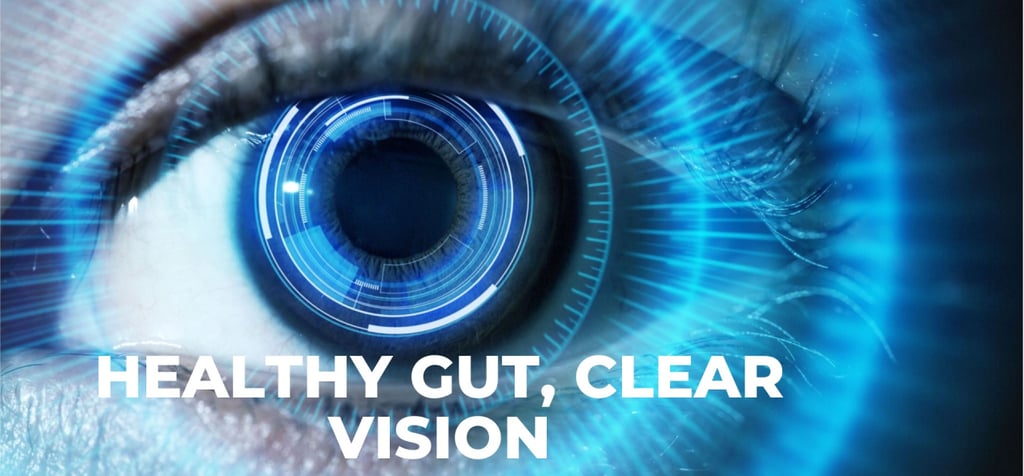The Gut-Brain-Liver-Eye Axis: Windows to Your Health
1. The Gut: The Powerhouse of Communication
Your gut is home to trillions of bacteria, collectively known as the gut microbiota. These microbes do more than just help with digestion—they produce key molecules like short-chain fatty acids (SCFAs), such as butyrate, which have far-reaching effects. Butyrate, for example, reduces inflammation not only in the gut but also in distant organs like the eyes (ocular inflammation). This anti-inflammatory effect, according to a study, can help protect against eye diseases like glaucoma and age-related macular degeneration (AMD).
However, when the gut microbiota falls out of balance—a condition called dysbiosis—it can lead to a "leaky gut," where harmful substances escape into the bloodstream. This triggers widespread inflammation, which can contribute to autoimmune conditions like Sjögren’s syndrome, a disorder that causes dry eyes and other symptoms. Research shows that restoring gut balance through probiotics and prebiotics can help alleviate these issues, highlighting the vital link between gut and eye health.
The Role of Immune Cells in the Gut-Eye Connection
Interestingly, in cases of gut dysbiosis, immune cells originating in the gut, such as Th17 cells, can become overactive and migrate to the eyes. These cells release inflammatory signals that damage the optic nerve and other ocular tissues, leading to vision loss. This process is particularly relevant in conditions like glaucoma and AMD, where chronic inflammation plays a key role in disease progression.
This connection is further supported by studies showing that germ-free mice (mice without gut bacteria) develop Sjögren-like Syndrome. When these mice were given a fecal microbiota transplant (FMT) from healthy mice, their ocular inflammation improved, demonstrating the critical role of gut bacteria in maintaining ocular immune balance.
2. The Brain: The Master Conductor
The brain is the central hub that processes signals from the gut and liver, influencing everything from mood to vision. When the gut or liver isn’t functioning well, it can impair brain function, including visual processing. But the connection goes both ways: the brain also sends signals that affect eye health.
Recent studies have revealed that the eye has its own lymphatic system, a network of vessels that manage immune responses. This system is directly linked to the brain via the optic nerve, creating a two-way street for immune communication. For example, boosting immunity in the eyes can protect the brain from infections and even aggressive tumors like glioblastoma. This discovery opens up exciting possibilities for treatments that target both eye and brain health simultaneously.
Moreover, the eyes aren’t just passive recipients of signals—they actively protect the brain. Immune signals from the eyes can shield the brain from infections and tumors, showcasing the deep interconnection between these organs. This bidirectional relationship highlights the importance of maintaining both brain and eye health.


3. The Liver: The Nutrient Processor
The liver is a multitasking organ that processes nutrients, detoxifies harmful substances, and regulates blood flow to the eyes. It also produces bile acids, which are now recognized as important signaling molecules that influence inflammation and eye health.
Liver problems, such as fatty liver disease or cirrhosis, can lead to vision issues like blurred vision or cataracts. For instance, non-alcoholic fatty liver disease (NAFLD) is linked to increased intraocular pressure (IOP), a key risk factor for glaucoma. The liver also plays a critical role in processing vitamin D, which is essential for eye health. Low vitamin D levels, often seen in people with liver issues, are associated with higher eye pressure and a greater risk of glaucoma.
The liver stores and processes other key nutrients for eye health, including vitamins A, C, and E, as well as zinc and selenium. These nutrients protect the eyes from oxidative stress and support retinal health. Ensuring a diet rich in these nutrients—or considering a multivitamin and mineral supplement—can help maintain both liver and eye function.
Liver dysfunction can also affect blood flow and nutrient delivery to the eyes, contributing to conditions like glaucoma and AMD. This highlights the liver’s critical role in maintaining not just overall health, but specifically ocular health.
4. East Meets West: The Liver's Expanded Roles
In Traditional Chinese Medicine (TCM), the liver is seen as a central organ that influences emotional well-being, blood storage, and eye health. TCM associates liver imbalances with visual disturbances like dry eyes and blurred vision—a concept that aligns with modern science’s understanding of the liver’s role in nutrient metabolism and inflammation.
In TCM, the liver is symbolized by the color green. Green is believed to calm and balance liver energy, supporting both physical and emotional health. From a Western perspective, the color green is also linked to health through chlorophyll, the green pigment found in plants. Chlorophyll plays a key role in detoxification and supports liver function.
5. Conclusion: The Interconnectedness of the Gut-Liver-Brain-Eye Axis
The gut-liver-brain-eye axis reveals the extraordinary interconnectedness of our body’s systems. From the gut’s production of anti-inflammatory metabolites like butyrate, to the liver’s role in processing essential nutrients for vision, to the brain’s bidirectional communication with the eyes via the lymphatic system, each organ plays a vital part in maintaining overall health. Disruptions in one area—whether from gut dysbiosis, liver dysfunction, or chronic stress—can ripple through the entire axis, leading to conditions like glaucoma, AMD, or even systemic inflammation.
This holistic perspective, supported by both modern science and Traditional Chinese Medicine (TCM), emphasizes that balance is key. By nurturing gut health, supporting liver function, and managing stress, we not only protect our vision but also promote overall well-being. The takeaway is clear: health is interconnected, and caring for one part of the body benefits the whole.
Return to:




